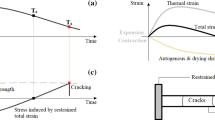Abstract
This paper reports a recent large-scale experimental investigation on early-age stress evolution in a deep underground concrete diaphragm wall. To evaluate the early-age stress induced by hydration temperature rise, autogeneous shrinkage and reinforcement restraint, both laboratory tests and in situ large-scale model wall test are performed. The laboratory tests include concrete adiabatic temperature rise, autogeneous shrinkage and restraint test. The in situ model wall simulates continuous and sliding design options for the external and inner layers with thermal and strain sensors installed in the inner layer. The restraint test results are interpreted via tensile creep modeling and an algorithm is conceived to calibrate the concrete tensile creep law. With the identified creep law, a thermomechanical analysis is performed on the model wall to calculate the concrete temperature and stress evolution at early age. The identified tensile creep law is furthermore validated by the numerical results and in situ measurements. Furthermore, the early-age stress analysis is performed on the full-scale diaphragm wall. Comments on the concrete tensile creep law and the diaphragm wall design option are given in the end.












Similar content being viewed by others
References
Springenschmid R (1998) Avoidance of thermal cracking in concrete at early ages. E&FN Spon, London
Comité Euro-International du Béton (1993) CEB-FIP Model Code. Bulletin d’information, No.213/214. Tomas Telford, London, p 473
American Concrete Institute Committee 209 (2005) Prediction of creep, shrinkage and temperature effects in concrete structures. ACI, Farmington Hills
Oluokun F, Burdette E, Deatherage H (1991) Elastic modulus, Poisson’s ratio and compressive strength relationships at early ages. ACI Mater J 88(1):3–10
Ulm FJ, Coussy O (1998) Couplings in early-age concrete: from material modeling to structural design. Int J Solids Struct 35(31–32):4295–4311
Ulm FJ, Coussy O (2001) What is a “massive” concrete structure at early ages? Some dimensional arguments. ASCE J Eng Mech 127(5):512–522
Bažant ZP (1982) Mathematical models for creep and shrinkage of concrete. In: Bažant ZP, Wittmann FH (eds) Creep and shrinkage in concrete structures. Wiley, New York, pp 163–256
Faria R, Azenha M, Figueiras JA (2006) Modelling of concrete at early ages: application to an externally restrained slab. Cem Concr Compos 28(6):572–585
Kwak HG, Ha SJ, Kim JK (2006) Non-structural cracking in RC walls. Part I. Finite element formulation. Cem Concr Res 36(4):749–760
Yuan Y, Wan ZL (2002) Prediction of cracking within early-age concrete due to thermal, drying and creep behaviour. Cem Concr Res 32(7):1053–1059
Yang W, Weiss WJ, Shah SP (2000) Predicting shrinkage stress field in concrete slab on elastic subgrade. ASCE J Eng Mech 126(1):35–42
Ostergaard L, Lange DA, Altoubat SA, Stang H(2001) Tensile basic creep of early-age concrete under constant load. Cem Concr Res 31(12):1895–1899
Umehara H, Uehara T, Iisaka T, Sugiyama A (1995) Effect of creep in concrete at early ages on thermal stress. In: Shringenschmid R (ed) Thermal cracking in concrete at early ages. E&FN Spon, London, pp 79–86
Morimoto H, Koyanagi W (1995) Estimation of stress relaxation in concrete at early age. In: Shringenschmid R (ed) Thermal cracking in concrete at early ages. E&FN Spon, London
See HT, Attiogbe EK, Miltenberger MA (2003) Shrinkage cracking characteristics of concrete using ring specimens. ACI Mater J 100(3):239–245
Cusson D, Hoogeveen T (2007) An experimental approach for the analysis of early-age behaviour of high-performance concrete structures under restrained shrinkage. Cem Concr Res 37(2):200–209
Zhang T, Qin WZ (2006) Tensile creep due to restraining stresses in high-strength concrete at early ages. Cem Concr Res 36(3):584–591
Yang EI, Yi ST, Lee HJ (2004) Mechanical characteristics of axially restrained concrete specimens at early ages. ASCE J Mater Civ Eng 16(1):35–44
Springenschmid R, Gierlinger E, Kiernozycki W (1985) Thermal stresses in mass concrete: a new testing method and the influence of different cements. In: Proc 15th ICOLD Congress, Lausanne, 1985, pp 57–72
Bažant ZP, Wu ST (1974) Rate-type creep law of ageing concrete based on Maxwell chain. RILEM Mater Struct 7:45–60
Bissonnette B, Pigeon M, Vaysburd AM (2007) Tensile creep of concrete: study of its sensitivity to basic parameters. ACI Mater J 104(4):360–368
Bažant ZP, Osman E (1976) Double power law for basic creep of concrete. RILEM Mater Struct 9(49):3–11
Bažant ZP (1972) Prediction of concrete creep effects using age-adjusted effective modulus. ACI J 19:212–217
Acknowledgements
The research is supported by Chengtou Investment Ltd., Tianjin City, China. The constructive discussion with Mr. Fei Li on the early-shrinkage results is gratefully acknowledged.
Author information
Authors and Affiliations
Corresponding author
Appendix: Parameter identification algorithm of tensile creep
Appendix: Parameter identification algorithm of tensile creep
Discretize the time domain from zero tensile instant t 0 to the expected end t end . For our analysis, t 0 = 15.0 h and t end = 336 h. The time interval is equal to 1.0 h. The parameter identification is summarized as follows:
-
(a)
Determine the search ranges and steps for tensile creep parameters,
$$\left\{\begin{array}{l}\phi_{0}: [\phi_{0}^{min},\phi_{0}^{max}], \Updelta\phi_{0}\\ d:[d_{min},d_{max}], \Updelta d \\p:[p_{min}, p_{max}], \Updelta p \\ \end{array}\right.$$(26) -
(b)
Select a parameter group [\(\bar{\phi}_0,\bar{d},\bar{p}\)] from the above search ranges, calculate the incremental creep strain from t 0 to t end through Eq. 16,
$$ \begin{aligned} \displaystyle{\Updelta_n^{n+1}\epsilon_{cr}}&=\displaystyle {\bar{\phi}_0\sum^{n-1}_{i=0}\bigg\{\frac{\sigma'(t_{i,\frac{1}{2}})}{E(t_{i,\frac{1}{2}})} t_{i,\frac{1}{2}}^{-\bar{d}}\big[(t_{n+1}-t_{i,\frac{1}{2}})^{\bar{p}}-(t_{n}-t_{i,\frac{1}{2}})^{\bar{p}}\big]\Updelta t_i^{i+1}\bigg\}}\\& \displaystyle{+\bar{\phi}_0 \frac{\sigma'(t_{n,\frac{1}{2}})}{E(t_{n,\frac{1}{2}})}t_{n,\frac{1}{2}}^{-\bar{d}}\bigg(\frac{\Updelta t_n^{n+1}}{2}\bigg)^{\bar{p}}}\Updelta t_n^{n+1} \end{aligned} $$(27) -
(c)
Calculate the accumulated integral error η in and absolute error η ab for this parameter group,
$$ \eta_{in}=|\epsilon_{cr}^f-\sum\limits^{t_{end}}_{t_n=t_0}\Updelta_n^{n+1} \epsilon^c_{cr}|/\epsilon_{cr}^f,\eta_{ab} =\hbox{Max} |\Updelta_n^{n+1}\epsilon_{cr}^f-\Updelta_n^{n+1} \epsilon^c_{cr}| $$(28)with \(\epsilon_{cr}^{f,c}\) signifying respectively the fitted and calculated tensile creeps.
-
(d)
Go to (b) until all the parameters groups are calculated. Then find the optimized parameter group by fixing the numerical tolerances for integral and absolute errors \(\bar{\eta}_{in,ab}\),
$$ \eta_{in} \le \bar{\eta}_{in},\quad \eta_{ab} \le \bar{\eta}_{ab} $$(29) -
(e)
If multiple groups are available from the above selection, decrease the tolerances \(\bar{\eta}_{in}, \bar{\eta}_{ab}\) until only one group is left.
Rights and permissions
About this article
Cite this article
Li, K., Ju, Y., Han, J. et al. Early-age stress analysis of a concrete diaphragm wall through tensile creep modeling. Mater Struct 42, 923–935 (2009). https://doi.org/10.1617/s11527-008-9432-4
Received:
Accepted:
Published:
Issue Date:
DOI: https://doi.org/10.1617/s11527-008-9432-4




